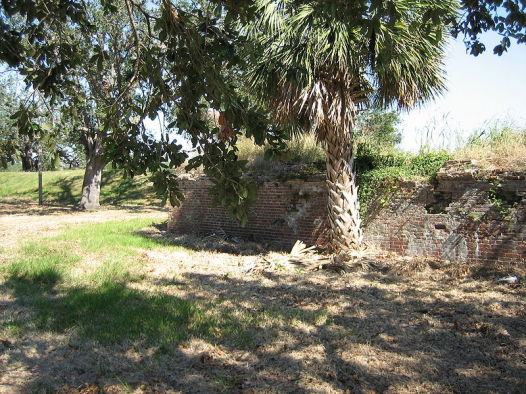
Present-day ruins of Fort St. John (Photo: Wikipedia)
Andrew Jackson was quoted upon his arrival to New Orleans in the fall of 1814 as saying, “I have never seen a city that is so defenseless with its infinite number of water routes in it.”
Jackson had a daunting challenge to defend New Orleans from a British attack that would eventually be the last military engagement of the War of 1812. After arriving in New Orleans in the fall of 1814, Jackson met with Jean Lafitte, the leader of a group of south Louisiana pirates known as the Baratarians. They were very familiar with the inland waterways that infiltrated the New Orleans area and its surrounding swamps.
Jackson needed scouts because of his unfamiliarity with the area. Additionally, he had no idea where to place his troops because he was not sure where the British would land. This is where Jean Lafitte and the Baratarians would come into play. Lafitte volunteered his services to Jackson; however, it was for a price. The Baratarians were wanted men for their piracy on the seas. In exchange for their help, Lafitte and his men would have to receive pardons for their crimes from Louisiana’s Governor William C. Claiborne. Jackson had little choice, as he needed his scouts.
On December 28, 1814, Andrew Jackson met with Jean Lafitte at a fort near the present-day intersection of St. Philip and Royal streets. Jackson sent Lafitte’s men to Fort St. John, at the mouth of Bayou St. John where it emptied into Lake Pontchartrain, to protect the northern boundary of New Orleans. Bayou St. John was well-known to Lafitte and the Baratarians, as they would traverse that waterway transporting illegal goods. Lafitte would place his men at Fort St. John under the leadership of Dominique You and Renato Beluche. Jackson would provide Major Jean-Baptiste Plauche to lead the forces at the fort on the mouth of Bayou St. John. Plauche’s battalion at Fort St. John would number 287 men which would include Baratarians and free blacks.
On December 22, 1814, scouts warned Andrew Jackson of the landing of British troops at the Villere Plantation in what is presently known as Chalmette. More than 2,000 British troops under the command of General Edward Packenham, with an additional 8,000 aboard British ships in the Mississippi River were brought in to defeat the Americans in New Orleans. Jackson needed men, artillery, and ammunition. These were housed at Fort St. John. Thus began the trek of the Baratarians led by Major Jean-Baptiste Plauche, down the muddy road from Fort St. John along Bayou St. John, carrying weapons, cannons, and ammunition. They met Jackson and his troops of 2,131 men at Fort St Charles, just on the perimeter of the present French Quarter.
The Baratarians joined Andrew Jackson and his troops, which now totaled approximately 5,000 men in the Place de Armes, now known as Jackson Square. They marched to Chalmette, where they set up a line of defense along the Rodriguez canal with the arms, ammunition, and cannons brought by the Baratarians. The Americans survived two waves of attack on January 8, 1815. General Packenham was killed along with 2,000 British soldiers. In retrospect, this battle was not necessary, as the Treaty of Ghent, which ended the war, had been signed beforehand.
The trek from Fort St. John to the French Quarter is commemorated today with the city’s oldest road race. The annual Jackson Day Race was first held on January 8, 1907. The next morning, articles in the New Orleans Picayune newspaper described the race with the following headlines: “Cross Country Run over Lafitte Course, Young Men’s Christian Association inaugurates race, along historic paths in honor of Jackson Day, Auto’s lined up before YMCA.” Additional quotations from the article described the route of the race: “History tells us how the garrison ran all the way to the Jackson Square (then Place de Armes) to join the other forces under Gen. Jackson.”
This year’s 108th Jackson Day Race, sponsored by the New Orleans Track Club, took place last Sunday.
 NOLAbeings Multimedia artist Claire Bangser created NOLAbeings as a portrait-based story project that marries...
NOLAbeings Multimedia artist Claire Bangser created NOLAbeings as a portrait-based story project that marries...  Voodoo in New Orleans: Reviving history: New Orleans fortune telling This article takes a deep dive into the history of Voodoo in New Orleans, its hybridization with Catholicism, and its present-day place in the city's culture. The author visits fortune-tellers in the French Quarter, using their guidance as a tool for introspection rather than a deterministic predictor of the future. Through her experiences in New Orleans, the author feels a mystical connection to both the past and the future.
Voodoo in New Orleans: Reviving history: New Orleans fortune telling This article takes a deep dive into the history of Voodoo in New Orleans, its hybridization with Catholicism, and its present-day place in the city's culture. The author visits fortune-tellers in the French Quarter, using their guidance as a tool for introspection rather than a deterministic predictor of the future. Through her experiences in New Orleans, the author feels a mystical connection to both the past and the future. 